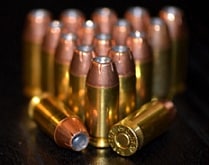The etymological origin of the term ammunition is found in Latin. Exactly it derives from “munitio”, which can be translated as “load that is placed in firearms” and which is the result of the sum of the following lexical components:
-The verb “munire”, which is synonymous with “reinforce” or “fortify”.
-The suffix “-cion”, which is used to indicate “action and effect”.
The concept of ammunition can be translated as “defensive wall” . The term is used to name the load of a firearm .
 An ammunition, therefore, is an element that is fired as a projectile . When the trigger of a firearm is pulled, concentrated chemical energy is released and the ammunition is mechanically propelled. This object passes through the tube or pipe while receiving a straight-line acceleration: whoever is in the path of the fired ammunition receives the impact.
An ammunition, therefore, is an element that is fired as a projectile . When the trigger of a firearm is pulled, concentrated chemical energy is released and the ammunition is mechanically propelled. This object passes through the tube or pipe while receiving a straight-line acceleration: whoever is in the path of the fired ammunition receives the impact.
The most common propellant for ammunition is gunpowder . It is a mixture of potassium nitrate, carbon and sulfur that produces a deflagration to propel the projectiles.
The characteristics of the ammunition depend on the weapon. They can be bullets , pellets or pellets , to name a few possibilities.
If we talk about military and police weapons we have to establish that there are several types of ammunition:
-Semi-armored, which is the most used by this type of agents and its cartridges usually have an approximate weight of 123 grams.
-FMJ (Full Metal Jacket), which is a lead bullet that is usually covered in brass or copper. The police and the military usually use it for training and shooting practices. It has another peculiarity: it is capable of passing through the body at which it is shot.
-Lead, whose cartridges usually have an approximate weight of 158 grams. It should also be noted that it is usually out of use since, sometimes, it can cause the weapon to jam.
In the same way, these types of agents can proceed to use other types of ammunition such as EMB, which weighs approximately 93 grams, and hollow ammunition, which contributes to achieving great precision. These, in addition, usually have a high price and their sale to individuals is prohibited.
A blank ammunition is one that does not have a projectile. It has gunpowder and the detonator (explosive matter), which is why it is used to perform special effects or simulations. When using a blank ammunition, the explosion is generated, but there is no bullet that is fired.
In the field of cooking , very small spherical noodles are called munitions. Generally, this type of pasta is usually eaten in soup: the ammunition is cooked in a boiling broth and, once they are ready to eat, they are eaten with the help of a spoon.
It should be noted that there are people who prepare ammunition soup with pieces of meat or vegetables. In this way the dish becomes more nutritious.
